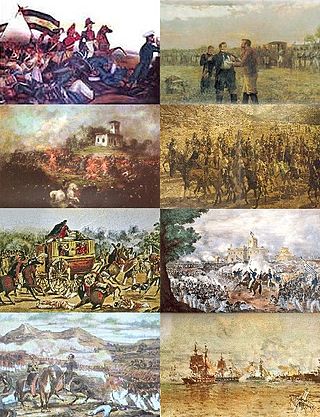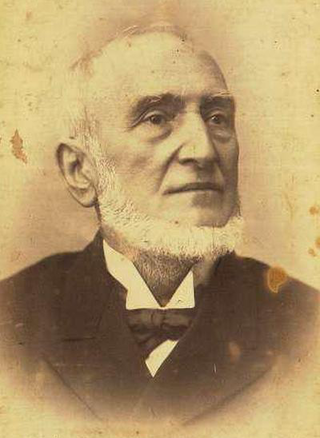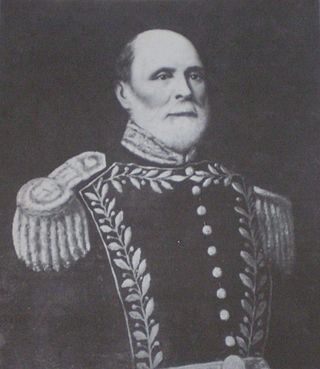| |||||
| Decades: | |||||
|---|---|---|---|---|---|
| See also: | Other events of 1851 List of years in Argentina | ||||
Events in the year 1851 in Argentina .
| |||||
| Decades: | |||||
|---|---|---|---|---|---|
| See also: | Other events of 1851 List of years in Argentina | ||||
Events in the year 1851 in Argentina .

The Argentine Confederation was the last predecessor state of modern Argentina; its name is still one of the official names of the country according to the Argentine Constitution, Article 35. It was the name of the country from 1831 to 1852, when the provinces were organized as a confederation without a head of state. The governor of Buenos Aires Province managed foreign relations during this time. Under his rule, the Argentine Confederation resisted attacks by Brazil, Bolivia, Uruguay, France and the United Kingdom, as well as other Argentine factions during the Argentine Civil Wars.

The Battle of Caseros was fought near the town of El Palomar, Argentina, on 3 February 1852, between forces of the Argentine Confederation, commanded by Juan Manuel de Rosas, and a coalition consisting of the Argentine provinces of Entre Ríos and Corrientes, the Empire of Brazil, and Uruguay.

Unitarianists or Unitarians were the proponents of the concept of a unitary state in Buenos Aires during the civil wars that shortly followed the Declaration of Independence of Argentina in 1816. They were opposed to the Argentine Federalists, who wanted a federation of autonomous provinces. Argentine unitarianism was an ideologic grouping, not a religious one. As such, it is unrelated to religious Unitarianism.

Brigadier General José María Paz y Haedo was an Argentine military figure, notable in the Argentine War of Independence and the Argentine Civil Wars.

The Federal Pact was a treaty first signed by the Argentine provinces of Buenos Aires, Entre Ríos and Santa Fe on 4 January 1831, for which a Federal military alliance was created to confront the Unitarian League. Other provinces would later join the treaty.

The Treaty of Pilar was a pact signed among the rulers of the Argentine provinces of Santa Fe, Entre Ríos and Buenos Aires, which is recognized as the foundation of the federal organization of the country. It was signed in the city of Pilar, Buenos Aires on 23 February 1820 by governor Estanislao López for Santa Fe, caudillo Francisco Ramírez for Entre Ríos, and provisional governor Manuel de Sarratea for Buenos Aires, after the dissolution of the national government caused by the Battle of Cepeda. A reference to it was included in the Preamble of the Argentine Constitution of 1853 as one of the "pre-existing pacts" fulfilled by it.

The Federal League, also known as the League of the Free Peoples, was an alliance of provinces in what is now Uruguay, Argentina and Brazil that aimed to establish a confederal organization for the state that was emerging from the May Revolution in the war of independence against the Spanish Empire.
Joaquín Madariaga was a soldier and Argentine politician. Madariaga was Governor of the Corrientes Province and leader of the provinces resistance against the national government of Juan Manuel de Rosas.

Ricardo Ramón López Jordán (1822–1889) was an Argentine soldier and politician, one of the last influential "caudillos" in the history of Argentina. He thrice rebelled against the government of Buenos Aires and was defeated in each attempt.

The Platine War was fought between the Argentine Confederation and an alliance consisting of the Empire of Brazil, Uruguay, and the Argentine provinces of Entre Ríos and Corrientes, with the participation of the Republic of Paraguay as Brazil's co-belligerent and ally. The war was part of a decades-long dispute between Argentina and Brazil for influence over Uruguay and Paraguay, and hegemony over the Platine region. The conflict took place in Uruguay and northeastern Argentina, and on the Río de la Plata. Uruguay's internal troubles, including the longrunning Uruguayan Civil War, were heavily influential factors leading to the Platine War.

The Argentine Civil Wars were a series of civil conflicts of varying intensity that took place through the territories of Argentina from 1814 to 1853. Beginning concurrently with the Argentine War of Independence (1810–1818), the conflict prevented the formation of a stable governing body until the signing of the Argentine Constitution of 1853, followed by low-frequency skirmishes that ended with the Federalization of Buenos Aires. The period saw heavy intervention from the Brazilian Empire that fought against state and provinces in multiple wars. Breakaway nations, former territories of the viceroyalty, such as the Banda Oriental, Paraguay and the Upper Peru were involved to varying degrees. Foreign powers such as the British and French empires put heavy pressure on the fledgling nations at times of international war.

The so-called Ejército Grande, also called the Ejército Grande Aliado Libertador, was the coalition army that in 1852, under the command of the governor of Entre Ríos, Justo José de Urquiza, invaded the provinces of Santa Fe and Buenos Aires and defeated Juan Manuel de Rosas's army, which until that moment was in command of the foreign relations of the Argentine Confederation.
The Battle of Caaguazú took place in Mercedes Department, in Corrientes Province, Argentina on 28 November 1841, during the Argentine Civil War, between the forces of Entre Ríos Province, commanded by brigadier Pascual Echagüe and Corrientes Province, under brigadier José María Paz, with a sound defeat of the Federal Party forces of Entre Ríos.

Pascual Echagüe, was an Argentine soldier and politician. He served as Governor of Entre Ríos and Santa Fe provinces and Minister of War and Navy during the governments of Urquiza and Derqui. He participated in the Argentine Civil Wars and the Uruguayan Civil War.

The Argentine Civil Wars were a series of internecine wars that took place in Argentina from 1814 to 1876. These conflicts were separate from the Argentine War of Independence, though they first arose during this period.
The Battle of Laguna Limpia, was part of the Argentine Civil Wars. It happened in the southwest of the Corrientes Province, Argentina on 4 February 1846, when the army under Entre Ríos Province governor Justo José de Urquiza, defeated and captured the commander of the vadvanced columns of Corrientes' army, Juan Madariaga.

Lucio Norberto Mansilla was an Argentine soldier and politician. He was the first governor of the Entre Ríos Province and fought in the battle of Vuelta de Obligado.

Nicanor Molinas was an Argentine lawyer, politician, and prominent official during the last years of the Argentine Confederation.

The Corrientes campaign or the Paraguayan invasion of Corrientes was the second campaign of the Paraguayan War. Paraguayan forces occupied the Argentinian city of Corrientes and other towns in Corrientes Province. The campaign occurred at the same time as the Siege of Uruguaiana.

Manuel Hornos was an Argentine general who participated throughout the Argentine Civil Wars and the Paraguayan War. He was known for his service at the Battle of Tuyutí where he was a major contributor to the Argentine victory at the battle.